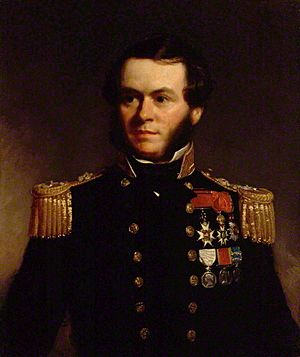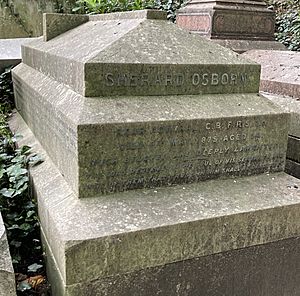Sherard Osborn facts for kids
Quick facts for kids
Sherard Osborn
|
|
|---|---|
 |
|
| Born | 25 April 1822 Madras, British India |
| Died | 6 May 1875 (aged 53) London, Middlesex, England |
| Branch | |
| Service years | 1837–1875 |
| Rank | Rear admiral |
| Wars | |
| Awards | |
Sherard Osborn was a brave Royal Navy admiral and a famous Arctic explorer. He was born on April 25, 1822, and passed away on May 6, 1875. He was known for his exciting adventures at sea and his important trips to the cold Arctic regions.
Contents
Sherard Osborn's life was full of adventure, from fighting in wars to exploring icy lands. He joined the Royal Navy at a young age and quickly showed his courage and skill. His journeys took him across the world, from the warm waters of the Pacific to the frozen Arctic.
Sherard Osborn was born in Madras, British India. His father was an officer in the Indian army. In 1837, when he was just 15, Osborn joined the navy as a volunteer. He served on several ships, learning the ropes of naval life.
By 1838, he was already in command of a small gunboat. He took part in an attack on Kedah in the Malay Peninsula. He also fought in important battles during the First Opium War in China, like the Battle of Canton in 1841 and the Battle of Woosung in 1842. From 1844 to 1848, he served as a gunnery mate and lieutenant on HMS Collingwood in the Pacific Ocean.
Arctic Expeditions
Osborn was very interested in finding Sir John Franklin, a famous explorer who had gone missing in the Arctic. In 1849, Osborn strongly supported sending new search teams. In 1850, he got to command the steam-powered ship HMS Pioneer (1850). This ship was part of an Arctic expedition led by Horatio Thomas Austin.
During this trip, Osborn made an amazing journey by sledge to the western part of Prince of Wales Island. He wrote a book about his experiences called Stray Leaves from an Arctic Journal (1852). Soon after, he was promoted to the rank of commander.
He joined another Arctic expedition from 1852 to 1854, again as commander of Pioneer. In 1856, he helped publish the journals of Captain Robert McClure. These journals told the story of how the Northwest Passage was discovered.
War Hero and Commander
In 1855, Osborn was called to fight in the Crimean War. He became captain of HMS Vesuvius (1839). He saw a lot of action in the Black Sea. In August 1855, he was promoted again to post-rank. He then commanded the squadron in the Sea of Azov until the war ended. For his brave service, he received several honors, including the Companion of the Order of the Bath, the Legion of Honour from France, and the Turkish Order of the Medjidie.
In 1859, he published a book that included some of the first Japanese illustrations seen in Europe since 1620. These images were from his travels to Edo (now Tokyo) in 1859.
As captain of HMS Furious, he played a big part in the Second Opium War. He skillfully navigated his ship up the Yangtse River to Hankow in 1858. He returned to England in 1859, not feeling well. During this time, he wrote many articles about naval topics and China. He also wrote The Career, Last Voyage and Fate of Sir John Franklin (1860).
In 1861, he commanded HMS Donegal in the Gulf of Mexico. In 1862, he took command of a group of ships for the Chinese government. These ships were meant to stop pirates along the coast of China. However, he left this job because the Chinese government did not keep their promise that he would only take orders from the emperor.
The Lay-Osborn Flotilla Story
During the Taiping Rebellion in China, the Chinese government wanted to take back control of Nanjing. This city had become the capital of the rebel forces. The government needed ships to move troops and provide fire support. So, they asked the British for help. The British agreed, hoping to bring peace and stability to trade in China.
The Chinese Emperor, who was in Jehol at the time, agreed to buy British gunboats. Horatio Nelson Lay was chosen to lead this new group of ships, called a flotilla. Lay traveled to England to arrange everything.
Queen Victoria of Britain agreed to the plan in September 1862. She gave permission to prepare the ships and hire crews. Lay then chose Captain Sherard Osborn to be the commander of this new Chinese flotilla.
Why the Flotilla Failed
On February 13, 1863, the "Lay-Osborn" flotilla, also known as the "Vampire" Fleet, left England. It had seven steam cruisers and a supply ship. They arrived in China in September 1863.
However, things quickly went wrong. Osborn refused to take orders from local Chinese officers. He said his agreement with Lay stated that all orders had to come directly from the Chinese Emperor, through Lay. The Chinese Imperial court did not agree to this. Because of this disagreement, Osborn resigned on November 9, 1863. He broke up the flotilla and sent all the ships back to England without them ever firing a shot. Lay was also fired by the Chinese government that same year.
Later Career and Legacy
In 1864, Osborn was given command of HMS Royal Sovereign. This was the first British battleship with a rotating gun turret. His job was to test this new type of ship design.
Later, he worked for railway and telegraph companies. He became an agent for the Great Indian Peninsula Railway Company in 1865. Two years later, he became a managing director for the Telegraph Construction and Maintenance Company. He held this job until 1874.
In 1871, he was appointed captain of HMS Hercules in the Channel Fleet. On June 12, 1873, he was promoted to rear admiral.
Osborn never lost his interest in Arctic exploration. In 1873, he encouraged Commander Albert Hastings Markham to take a summer trip to the Arctic. This trip was to test how steamships could navigate through ice. The results of this trip led to the British Arctic Expedition, led by Sir George Nares. Osborn became a member of the committee for this expedition.
His Final Journey
Sherard Osborn passed away in London on May 6, 1875. This was just a few days after the British Arctic Expedition had set sail. He was buried at Highgate Cemetery on May 10, 1875. Many people who had served with him in the Royal Navy attended his funeral.
A cable ship, the SS Sherard Osborn, was named after him. It was launched in 1878.


